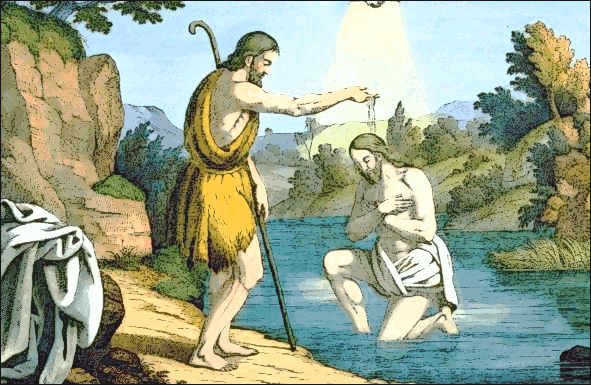 |
| John baptizes Jesus, courtesy of http://www.wpclipart.com |
To appreciate who Baptists are to-day, as individuals and as a community, requires some history, to identify Baptists properly. I offer the wise words of George Santayana for your consideration, that ‘the fate of those who forget their past is to have to relive it’. Don’t let ‘history’ put you off, reliving it can be very painful.
Two thousand years ago, a radical, rough-hewn, personality called ‘John the Baptizer’, out in the Palestinian wilderness, called people to repentance for sin, and to be prepared for the coming of Israel’s Messiah. A sign of their response was to be baptized, by immersion, in the Jordan river. Jesus, who came from Nazareth, became part of John’s programme, and was baptized by John in the Jordan. When his life, crucifixion, and resurrection were completed, Jesus commanded his followers to ‘Go out and train everyone you meet, far and near, in this way of life, marking them by baptism in the three-fold name: Father, Son and Holy Spirit. Then instruct them in the practice of all I have commanded you.’[E H Peterson, The Message, p.73] This dramatic symbol of rebirth and commitment to Jesus, very quickly became the way of initiation into the rapidly spreading Christian communities in the Mediterranean world, and was closely identified with the observance of the Lord’s Supper, as instituted by Jesus, as commands of Christ that cannot be ignored.
As the Church grew over the centuries, variations occurred in the way baptism was performed, the appropriate age of the candidate, the exact requirements of the baptized or their sponsors, and who could baptize new Christians. By 300 AD most new born children of Christian parents were thought to be proper recipients of baptism, though some Christian groups thought baptism should be only for people making a conscious confession of their faith in Christ, and affirmed their willingness to walk the Christian way.
It was not until the Renaissance [the re-birth of Greek and Latin literature and architecture] and the Reformation of the Church [by leaders such as Luther, Zwingli, Calvin] that the consideration of baptism came to the forefront in Christian thinking. An important reason for this was the translation of the Bible into English. The first English version was the Genevan Bible[1560] published with detailed commentary notes of a Calvinist flavour. It was the Bible most widely read in private use in England until 1611 when the King James version was produced. It was a major change in England, that all literate people could read the Bible for themselves. This combined with the earlier invention of printing produced a church revolution. In the early days of these changes, one young scholar, Thomas Linacre, at Cambridge University when he read Erasmus’s printed version of the Gospels in Greek for the first time, was alleged to have declared: ‘Either this is not the Gospel or we are not the Church’. Many others agreed as they compared the Church of their day with the pristine Gospel story. Some of these became Baptists, finding support and encouragement from the Bible and the example of some European Anabaptists, or re-baptizers, which we consider next.
ROGER HAYDEN
No comments:
Post a Comment